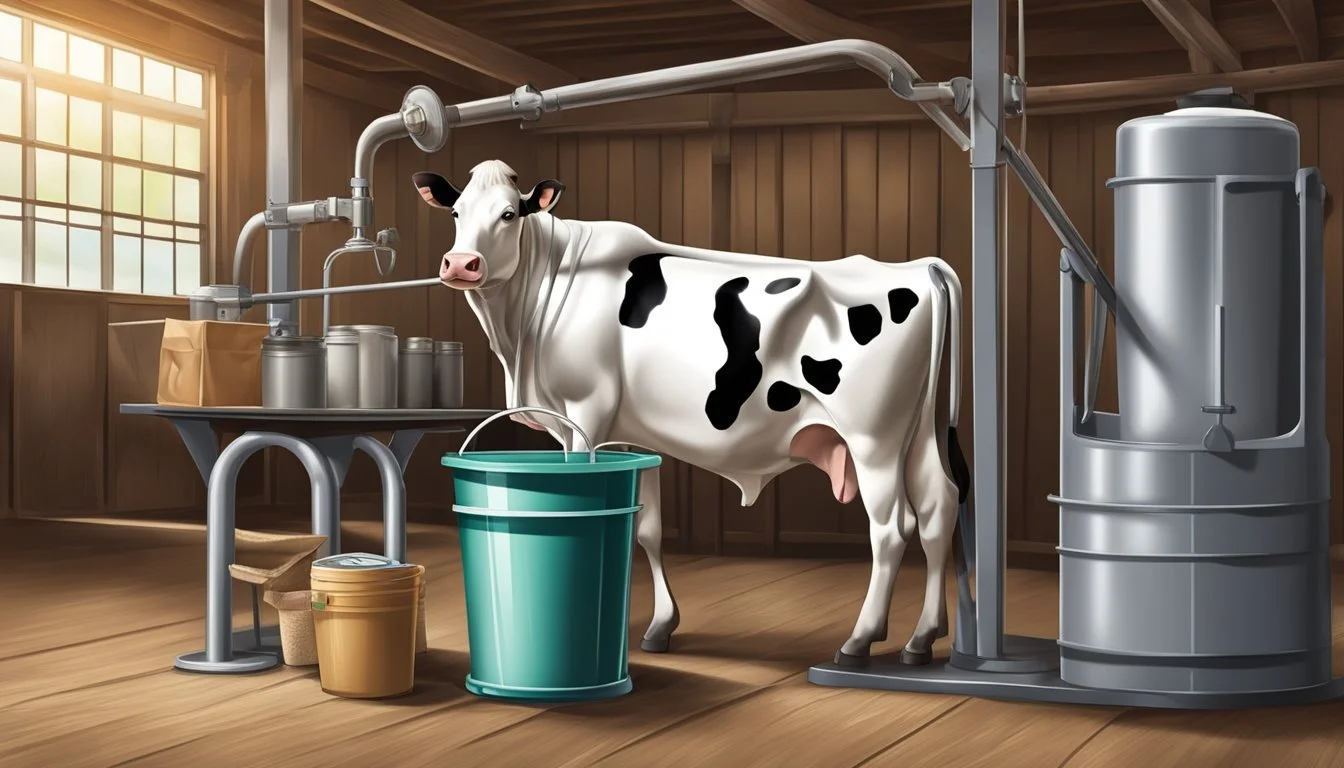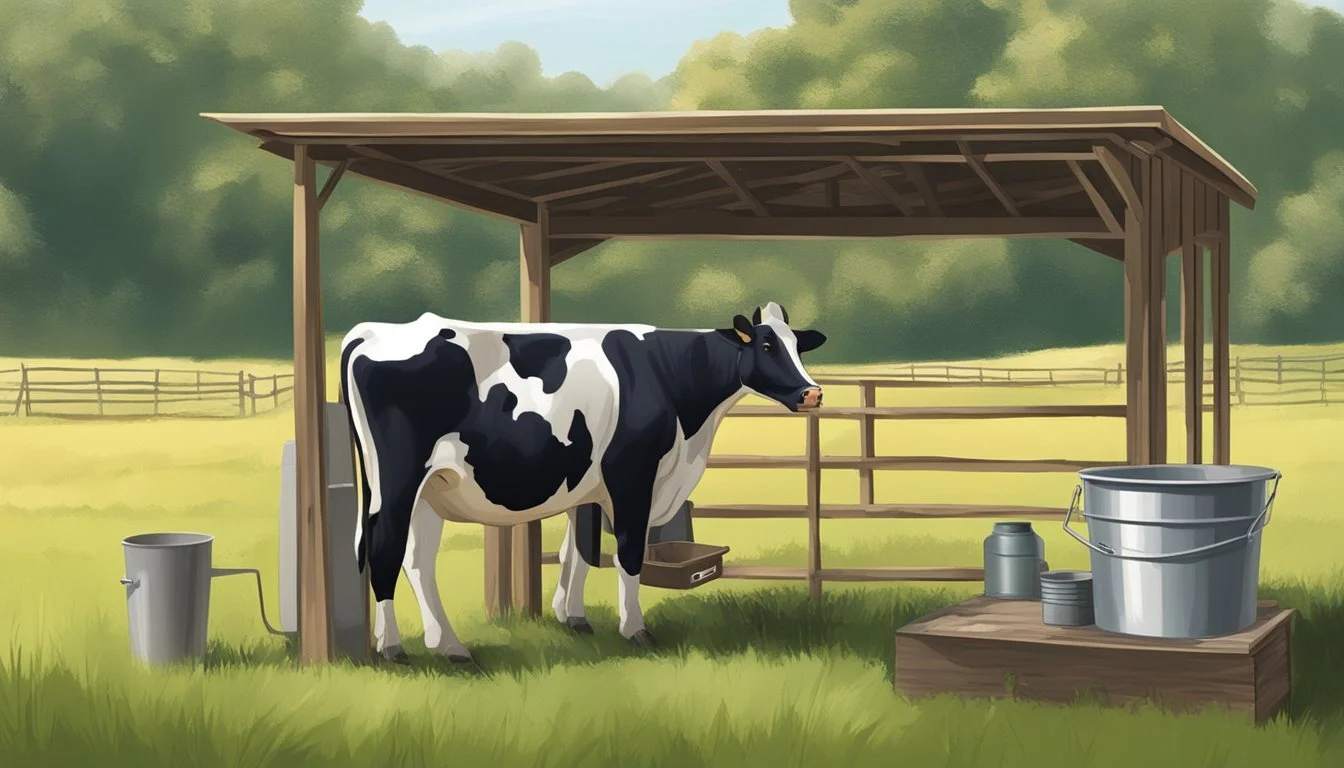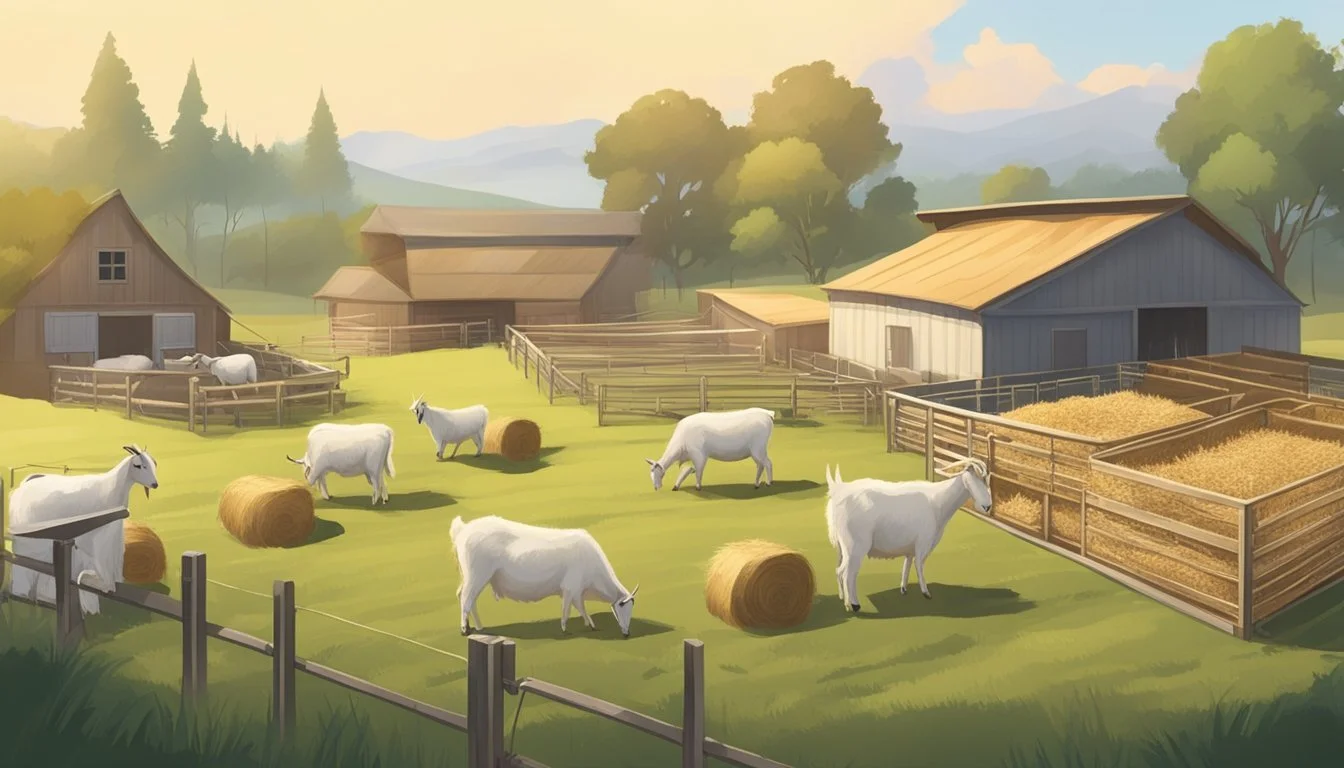Milking Goat Equipment Essentials
Key Tools for Efficient Homesteading
Raising goats on a homestead provides a reliable source of fresh milk, but it requires the right equipment to ensure the process is efficient, sanitary, and comfortable for both the animals and the farmer. Essential milking equipment includes stainless steel pails, which are preferred for their durability and ease of sanitization. Using stainless steel milking pails is crucial because they don't impart off-flavors to the milk and are easier to keep clean compared to other materials, like plastic.
Before the milking process begins, the goat's udder needs to be cleaned to prevent contamination. Options for this include commercial dairy udder washes or a simple homemade solution consisting of water, vinegar, and a drop of dishwashing detergent. Ensuring the cleanliness of the goat and the equipment is paramount to maintaining the quality of the milk.
Adequate storage for the milk after collection is another important consideration. Glass jars or containers are often used for storage as they do not react with the milk and can be easily sterilized. Keeping these essentials in mind, homesteaders can effectively set up their goat milking operation for success, contributing to a self-sufficient lifestyle.
Understanding the Basics of Goat Milking
Proper milking of dairy goats is crucial for the production of high-quality milk and maintaining the health and productivity of the animals. This section provides a clear understanding of the milking schedule, essentials of a milking stand and stanchion, and the appropriate equipment needed for efficient and safe milking.
The Importance of Milking Schedule
A consistent milking schedule is vital for the health and well-being of dairy goats. They need to be milked at regular intervals to maintain milk flow and to prevent discomfort or potential issues such as mastitis. Typically, dairy goats are milked two times a day, approximately 12 hours apart. This routine not only ensures substantial milk yield but also promotes the welfare of the goats by preventing udder engorgement.
Milking Stand and Stanchion Essentials
Utilizing a milking stand or goat stanchion is essential for home dairying. These structures provide a secure and comfortable space for goats during milking sessions. A good milk stand should be:
Sturdy and well built
Adjustable to fit various goat sizes
Equipped with a head catch to gently restrain the goats
A goat stanchion serves as a restraint device, allowing safe and easy access to the udder. By raising the goat to a convenient height, the stand aids in reducing the strain on the farmer's back.
Choosing the Right Milking Equipment
Choosing the correct equipment is vital for an effective milking routine. High-quality, durable, and easy-to-clean milking supplies are non-negotiable for a successful milking process. The two most important pieces of equipment are:
Milking Machine: For those looking to streamline the process, a milking machine automates the milking routine, enhancing efficiency and reducing labor.
Milking Pail: Always opt for a stainless steel milking pail. Stainless steel is recommended due to its durability and ease of sanitization, crucial for maintaining the milk's purity and taste.
Setting Up Your Milking Area
Successful milking begins with a properly designed space. A thoughtful setup contributes to efficient workflows, which in turn can lead to more productive and easier milking sessions.
Designing a Functional Barn Layout
The layout of the barn plays a crucial role in creating a stress-free environment for both the livestock and the labor involved in milking. Central to this is a milking area that allows for easy movement of the animals and provides adequate space for handlers. When designing the barn, considering the placement of electrical outlets and lighting is essential for operating milking equipment and ensuring visibility during early morning or late evening sessions.
Milking Stands: Ensure that each stand is accessible and has sufficient space around it for handlers to move freely.
Equipment Storage: Locate storage areas close to the milking stands for quick access to goat milking equipment like milk strainers and canning funnels.
Creating Efficient Milk Handling Workflows
Efficiency in milk handling workflows starts with well-organized milking routines. Implementing a consistent process for cleaning, collecting, straining, and storing milk is key to maintaining milk quality.
Before Milking:
Prepare Equipment: Have all milking equipment sanitized and ready.
Setup Cleaning Station: Ensure a cleaning station is nearby for washing and drying udders before milking.
During Milking:
Milk Collection: Use a stainless steel milking pail to collect milk, as plastic can affect milk taste and is harder to sanitize.
Strain Immediately: Immediately strain the milk using a milk strainer to remove impurities.
After Milking:
Transfer to Storage: Funnel the strained milk through a canning funnel into storage containers.
Cool Quickly: Store the milk in a cool place promptly to preserve freshness.
By streamlining the path from goat to storage, labor is minimized, and the risk of contamination is reduced, ensuring that the collected milk remains of the highest quality.
Milking Equipment Hygiene and Maintenance
Maintaining the hygiene and integrity of milking equipment is paramount to ensure the quality of milk and the health of dairy goats. Regular sanitation and thorough inspection for milk abnormalities are critical components.
Sanitization Procedures for Equipment
Proper sanitation of milking equipment begins with dismantling all parts that come in contact with milk. They should meticulously clean glass jars, stainless steel containers, and any plastic lids by using hot water and an appropriate dairy sanitizer. After cleansing, it is essential to rinse the equipment with potable water to remove any residual sanitizer that can cause off-flavors in the milk or harm the goats. For optimal results, they should introduce a filter system within the cleaning process to eliminate debris.
Daily steps include:
Rinse equipment with cool water to remove milk residue.
Wash with hot water (at least 165°F) and detergent.
Sanitize with an appropriate dairy-approved sanitizer.
Air dry on a rack to prevent contamination from towels.
Detecting and Addressing Milk Abnormalities
Detecting abnormalities in milk involves both visual inspection for changes in color or consistency and olfactory assessment for any off-odors. They should perform these checks immediately after milking to ensure any issues can be addressed promptly. If abnormalities are detected, it's important to review the entire sanitation process and the health of the dairy goats as potential factors. Equipment should be re-sanitized, and if issues persist, components of the milking system may need to be replaced or a comprehensive review of herd health initiated.
Key indicators include:
Aromatic changes: Unusual odors can signal contamination or infection.
Color variations: Discoloration can indicate the presence of blood or other contaminants.
Texture inconsistencies: Clotting or separation might reveal bacterial growth or poor handling.
By adhering to these stringent cleaning protocols and remaining vigilant for changes in the milk's properties, they can maintain a safe and sanitary milking environment.
Supplementary Goat Care for Improved Milking
A successful milking routine involves more than just the act of milking; it encompasses thorough care of the udder and strategic feeding and pasture management to enhance milk production and quality.
Importance of Udder Health
Maintaining udder health is pivotal for dairy goats. An udder compromised by infections such as mastitis can significantly reduce milk yield and quality. Regular udder washing before milking assists in preventing contamination and mastitis, while post-milking, an udder balm or teat dip promotes healing and protection against bacteria. Farmers should incorporate this regime using clean and sanitized goat milking equipment to maintain udder integrity and sustain milk production levels.
Feeding and Pasture Management
Diet directly influences a goat's milk output and quality. A balanced diet rich in nutrients supports overall health and lactation. A combination of high-quality hay, commercial feed formulated for lactating goats, and fresh water is essential. Additionally, incorporating a cover crop guide for pasture rotation can provide a variety of beneficial plants that add to the goats' diet, resulting in better milk. Pasture management, including avoiding overgrazing and providing ample space, ensures that the animals have access to fresh, nutrient-dense forage, bolstering their health and milk production capacity.
Container and Storage Solutions
Choosing the right containers and employing proper milk preservation techniques are critical for maintaining the quality of goats' milk on a homestead. These decisions impact the milk's freshness, taste, and safety.
Selecting Suitable Containers
Selecting the appropriate container for milk collection and storage is essential. Glass jars are a popular choice due to their non-porous nature, which prevents odors and flavors from seeping in. Quart Mason jars are convenient for small-scale storage, but one must ensure they have a tight-sealing plastic lid to keep milk secure. For larger quantities, stainless steel pails or buckets provide durability and ease of cleaning, which helps maintain milk purity. It's crucial that these metal containers are of high quality, as poor-grade materials can affect the raw milk's taste and safety.
Glass: Non-porous and flavor preserving
Types: Mason jars, other glass jars
Size consideration: Quart size is standard
Lid necessity: Requires secure plastic lid
Stainless Steel: Durable and easy to sanitize
Types: Stainless steel pail, stainless steel bucket
Capacity: Suitable for both small and large volumes
Sanitation: Must be thoroughly cleaned to ensure milk safety
Effective Milk Preservation Techniques
Preserving the freshness and purity of milk begins with proper filtration and storage. Using a milk filter when transferring milk to a container can capture any unwanted debris, ensuring cleaner milk for consumption or sale. Raw milk should then be cooled rapidly to inhibit bacterial growth; this involves storing it at consistent, cold temperatures as soon as possible after collection. For extended freshness, it's advisable to store milk in either glass or stainless steel containers instead of plastic, as the latter can sometimes impart flavors and is more challenging to sanitize.
Filtration
Tool: Milk filter
Purpose: Ensures cleanliness by removing debris
Cooling and Storage
Temperature: Raw milk requires rapid cooling and consistent cold temperatures
Material preference: Glass and stainless steel over plastic for flavor preservation and sanitation
Daily Milking Procedures
Effective daily milking procedures are instrumental for the health of the goats and quality of the milk yielded. It is crucial to decide between hand milking and using a milking machine, as well as to establish a consistent milking routine that incorporates equipment like a milk stand and potentially a hobble for safety.
Milking by Hand vs. Machine
Milking by Hand: This traditional method requires no specialized machinery. A milk stand is often used to restrain the goat comfortably during the process. Hand milking allows for a direct connection with the animals, can be more budget-friendly, and is portable. On the downside, it can be time-consuming and less consistent compared to machines.
Milking Machine: An investment in a milking machine can save time and ensures a consistent milking routine. These devices can reduce the labor required and are beneficial for larger herds. While machines add efficiency, they also necessitate routine maintenance and cleaning to prevent contamination.
Implementing a Consistent Milking Routine
A milking routine is paramount for the wellbeing of dairy goats and the milk's safety. Key steps include:
Cleaning: Prior to milking, clean the udder to ensure the milk is uncontaminated.
Schedule: Set and adhere to a milking schedule to keep the goats’ milk production stable—usually twice a day, approximately 12 hours apart.
Process: Whether by hand or machine, the process should be gentle to keep the goats calm and cooperative.
Safety: Use a hobble if necessary to prevent kicking. A well-designed milk stand can provide stability and comfort for both goat and milker.
Post-milking: After milking, treat the teats with a disinfectant to prevent infection.
By following these outlined steps, homesteaders can ensure the health of their dairy goats and the quality of the milk produced.
Additional Tools and Accessories
In maintaining the productivity and sanitation of a homestead dairy operation, certain tools and accessories are indispensable. Beyond the milking machine and storage containers, there are items that streamline the milking process and ensure the health of the dairy goat.
Assessment Tools for Dairy Production
Strip Cup: It's crucial for detecting mastitis early. By milking the first few streams into a strip cup, one can inspect for clots or abnormal milk before continuing with regular milking.
Milk Weight Scale: Accurate measurement of milk yield can help assess a goat’s health and productivity. Calibrated scales ensure precise data collection.
Multipurpose Farming Implements
Milking Pail: Opt for a stainless-steel milking pail for its durability and ease of sanitization. Stainless steel does not harbor bacteria like other materials, which is essential for milk quality.
Udder Wash System: An udder wash is vital for cleaning the udder before milking. Many opt for a homemade formula that often includes water, vinegar, and a gentle soap.
Teat Dip: Post-milking, use an iodine solution as a teat dip to prevent infections. It's a precautionary measure against bacteria entering the teat canal after milking.
By implementing these additional tools and accessories, homesteaders can ensure a more efficient and hygienic milking process, which is vital for the welfare of the dairy goats and the quality of the milk produced.
Producing Dairy Products at Home
Producing dairy products at home enables one to transform fresh milk into a variety of rich, flavorful foods. With the right equipment and a bit of patience, it's possible to create cheese, butter, yogurt, and more.
Making Cheese, Butter, and Other Dairy Items
Cheese: Starting with fresh goat milk, homemade cheese production involves curdling the milk, cutting the curd, and pressing it into desired shapes and sizes. Varieties such as ricotta or cheddar can be crafted from goat milk, each with its own set of instructions and necessary cultures.
Butter: Making butter requires the separation of cream from the milk, which can be done with a cream separator or by allowing fresh milk to sit until the cream rises. The cream is then churned, either manually or with an electric churner, until it solidifies into butter.
Yogurt and Sour Cream: With the aid of a yogurt maker or a controlled warm environment, one can incubate milk with specific bacteria, resulting in tangy yogurt. For sour cream, cream is fermented with lactic acid bacteria to achieve its characteristic tartness.
In home dairying, sanitary practices are essential; using clean and sterilized equipment ensures product safety and quality. One's efforts in home dairy production can yield delightful results, bringing the joys of fresh dairy products to the family table.
Livestock Management Beyond Goats
Successfully managing livestock on a homestead requires consideration of how different animals can coexist and support the overall functioning of the farm. From chickens to cattle, each species requires specific care, equipment, and training.
Integrating Other Farm Animals
Beyond goats, homesteading often involves the inclusion of other farm animals such as chickens and cattle. Chickens, for instance, contribute to pest control and provide eggs, requiring coops and fenced runs for protection. They demand less labor than goats, making them a practical addition. On the other hand, integrating a milk cow can substantially increase the homestead's dairy production but also necessitates larger spaces, sturdy fencing, and more robust milking equipment.
Chickens: Coops, nesting boxes, feeders
Cattle: Barns, milking stations, pasture land
Training and Equipment for Multiple Species
When managing multiple species, appropriate training is crucial for safety and efficiency. A trained dog can be beneficial for herding and protecting livestock on a homestead. Equipping such dogs with a proper dog leash or harness ensures control during training sessions. For kidding and cattle birthing, specialized knowledge in birthing assistance and immediate care is vital.
Trained Dogs: Harnesses, command training
Kidding/Cattle Birthing: Assistive tools, sanitary birthing areas
Diverse livestock management extends beyond goat milking essentials and incorporates a broad spectrum of care practices tailored to each animal’s needs.








